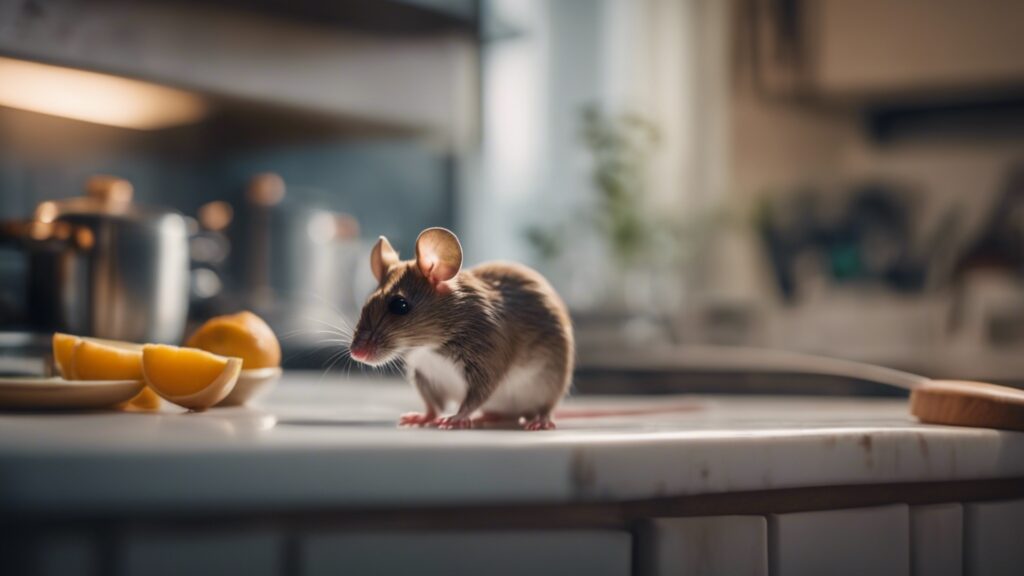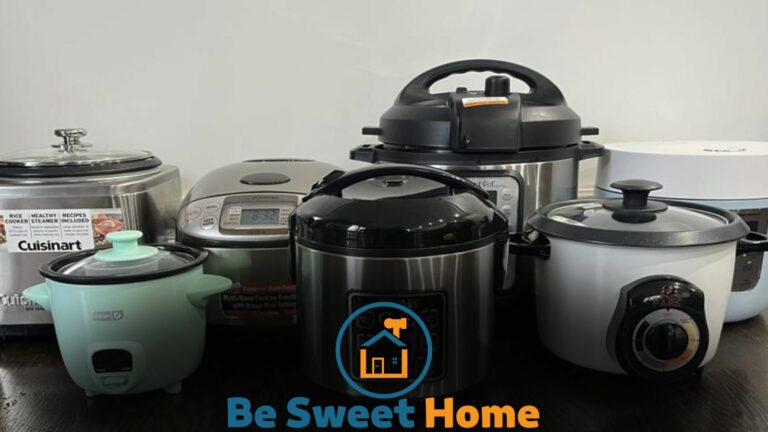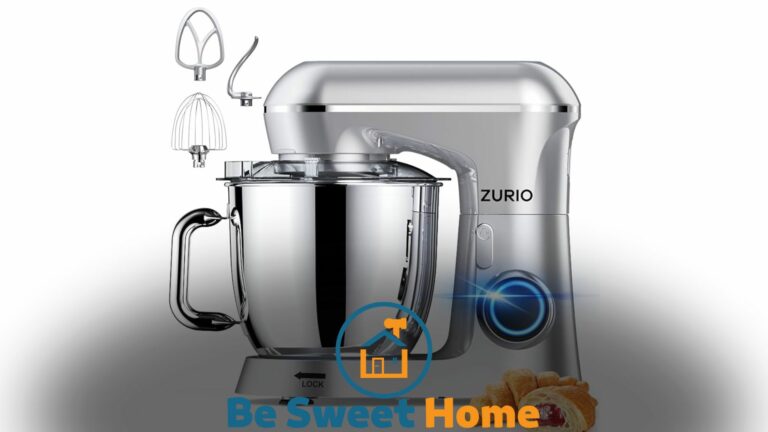

If you spot a mouse in your kitchen, immediately seal any open food and remove crumbs or spills. Next, set traps or contact a pest control professional.
Discovering a mouse in your kitchen can be a startling experience, often indicative of a more significant issue.
Mice are attracted to food sources, bringing health risks and property damage if not promptly addressed. Dealing with the situation quickly is crucial for your home’s hygiene and peace of mind.
It is essential to clean and sanitize surfaces where mice may have roamed. Such proactive measures and sealing entry points can help prevent future infestations.
Remember, mice can multiply rapidly, making it imperative to act immediately upon the first sign of their presence.
With practical strategies, you can reclaim your kitchen from these unwelcome guests and ensure it remains a clean and safe environment for your household.
Initial Shock: A Mouse in Your Kitchen
Discovering a mouse in your kitchen can be startling. The sudden appearance of this tiny, unexpected visitor has a way of causing immediate distress.
Mice are a nuisance and pose health risks due to the pathogens they can carry. It’s crucial to handle the situation thoughtfully.
Remaining Calm and Collected
The first step is to stay calm. Panicking could lead to hasty decisions that might not be effective. Take a slow, deep breath. Calmness allows for clear thinking and better solutions.
Remember, mice are more afraid of you than you are of them. They’re looking for food or shelter, not a confrontation.
Assessing the Situation: Size and Location
Try to determine the mouse’s size and location. A smaller mouse might suggest a recent infestation, potentially easier to control.
Note where the mouse is – near food sources or potential nesting areas? Identifying their location helps in creating a plan to remove them.
Use the following list to assess the situation:
- Size: Small or large mouse?
- Location: Where is the mouse?
- Entry Points: Look for holes or gaps they may have used.
- Signs of More: Droppings or damage indicate more mice.
Address the problem promptly. Mice reproduce quickly, which can make a small problem big. You may want to set traps or contact a professional for help.
Immediate Steps To Take
Discovering a mouse in your kitchen can be startling. Your immediate reaction is crucial. Follow these steps to safeguard your space and confront the unexpected visitor.
Safety Precautions for Food and Utensils
Begin by addressing the safety of your food and utensils:
- Inspect all food packages for signs of nibbling or contamination.
- Seal up any open food in airtight containers.
- Transfer unsecured food to the fridge or a mouse-proof pantry.
- Wash all utensils and surfaces that might have come into contact with the mouse.
Containing the Mouse: Tips and Strategies
Take these strategic steps to contain the mouse:
- Close all doors of the kitchen to limit the mouse’s movement.
- Remove pets and children from the area to avoid stress and possible harm.
- Use a light source to guide the mouse into a confined space.
- Set up traps around the kitchen, focusing on edges and potential entry points.
- Opt for humane traps if you prefer a catch-and-release method.
Identifying Entry Points
Finding out how mice enter your kitchen is crucial to preventing an infestation. These little critters only need a small gap to enter your home.
It’s like a welcome sign for them. Let’s locate these unwanted doorways and seal them tight.
Common Access Routes for Mice
Mice are tiny, agile creatures. They squeeze through the smallest openings. Check these places they may use:
- Windows and doors: Look at the edges.
- Pipes and vents: Spaces around these can invite mice.
- Wall cracks: Even thin cracks can be a path for them.
- Roof: Look for loose tiles or gaps near the eaves.
Sealing Gaps and Cracks
It’s time to block those entry points:
- Inspect your home: Go room by room, checking for holes.
- Use the right materials: Steel wool and caulk work best.
- Don’t forget the exterior: Secure the outside to keep mice out.
By sealing up gaps and cracks, you can make your kitchen less inviting to those pesky mice. Ready to say goodbye to uninvited guests? Tighten up your defense and enjoy a mouse-free space.
Cleaning and Sanitization
Spotting a mouse in the kitchen can be unnerving. Your top priority should be cleaning and sanitization to ensure the area is free from germs and bacteria that mice could spread. Taking quick and thorough action is key to maintaining a clean, safe environment.
Disinfecting Surfaces Affected
Once a mouse invades your kitchen, it’s critical to disinfect all surfaces. Mice can contaminate counters and utensils with harmful microorganisms.
Clean counters, tables, and appliances with an EPA-registered disinfectant. Always follow the product instructions for the best results.
- Use gloves to avoid direct contact with surfaces.
- Let the disinfectant sit for the recommended contact time.
- Wipe surfaces with a damp cloth to remove the cleaning agent.
Handling Mouse Droppings Safely
Mouse droppings are not only unpleasant but potentially harmful. Never touch droppings without gloves. To safely clean them, follow these steps:
- Don disposable gloves before cleaning.
- Spray droppings with a bleach solution (1 bleach to 10 parts water).
- Let the solution soak droppings for 5 minutes.
- Wipe them with paper towels and dispose of them in a sealed bag.
- Disinfect any tools used, like a dustpan or brush.
- Thoroughly wash your hands with soap and water after removing gloves.
Prevention and Deterrence
Finding a mouse in the kitchen can cause quite a stir. Don’t panic. Focus on preventing these guests rather than just reacting to their presence.
Natural Repellents and Their Effectiveness
Natural repellents offer a safe way to discourage mice without turning to harsh chemicals.
- Peppermint Oil: Mice dislike its strong smell. A few drops of cotton balls around your kitchen can keep them away.
- Cloves and Cayenne: Their pungent odors are great for deterring mice. Sprinkle these spices in corners or make a spicy sachet.
- Steel Wool: Placing steel wool in gaps can deter mice. They can’t chew through this tough material.
Regularly refresh these repellents to maintain their effectiveness.
Making Your Kitchen Less Attractive To Rodents
Keeping mice out is about making your kitchen uninviting to these tiny intruders.
| Task | Details | Frequency |
|---|---|---|
| Clean Regularly | Wipe surfaces, clean floors, and clear crumbs immediately. | Daily |
| Store Food Properly | Use sealed containers for food items including pet food. | As needed |
| Manage Waste | Empty the trash can regularly and use one with a lid. | Daily |
| Seal Entry Points | Fill holes with caulk, check for gaps in doors and windows. | Quarterly check |
Long-term Solutions and Professional Assistance
Finding a mouse in your kitchen can be alarming. Taking steps for long-term prevention is crucial not only to get rid of them today but to keep them away for good.
This includes DIY measures and seeking professional help to seal your home against future furry invaders.
When To Call Pest Control Experts
It is essential to recognize when a situation warrants expert intervention. Call pest control:
- Multiple sightings of mice or signs like droppings.
- An unsuccessful attempt at DIY traps.
- The presence of nests or mice in hard-to-reach areas.
- Concerns about disease transmission or damage.
Exploring Permanent Fixes To Rodent Problems
For permanent fixes:
- Seal all entrances that rodents might use to enter your home.
- Keep your kitchen and dining areas crumb-free and tidy.
- Store food in airtight containers to reduce the attraction.
Consider routine inspections to ensure your home remains rodent-free.
| Check for gaps; use steel wool and caulk | DIY | Professional |
|---|---|---|
| Sealing Entry Points | Check for gaps using steel wool and caulk | Comprehensive sealing, professional-grade materials |
| Food Storage | Use containers with tight lids | Recommendations on best practices and products |
| Regular Maintenance | Cleaning, decluttering | Inspections, follow-up treatments |
Remember: Combining immediate measures with long-term strategies and possibly professional help is the key to a rodent-free kitchen.

Frequently Asked Questions
What Attracts Mice To Kitchens?
Mice are drawn to kitchens by easily accessible food, water, and warmth, making them ideal harborage spots for these pests.
How Can You Humanely Remove a Mouse?
To humanely remove a mouse, use a live trap and release it far from your home, ensuring it doesn’t return.
Is a Mouse in the Kitchen an Emergency?
A single mouse isn’t an emergency, but it’s important to address the issue promptly to prevent an infestation.
Can Mice in the Kitchen Cause Diseases?
Mice can transmit diseases and contaminate food surfaces and supplies in the kitchen, posing health risks.
What Signs Indicate a Mouse Infestation?
Signs of a mouse infestation include droppings, gnawed packages, and scratching noises, especially at night.
Conclusion
Encountering a mouse in your kitchen can be alarming, but there’s no need to panic. Prompt action is key to preventing a minor sighting from turning into a full-blown infestation. Seal gaps, keep clean, and consider traps or professional help.
Your swift response will restore peace and hygiene to your culinary space.







